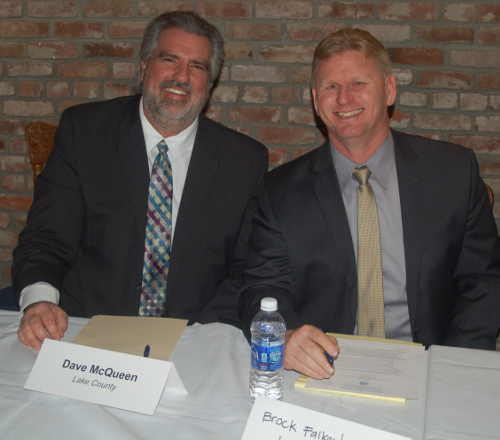
NORTHERN CALIFORNIA – On Wednesday, State Superintendent of Public Instruction Tom Torlakson and Sen. Mike McGuire hosted a critical bipartisan meeting of influential Northern California business, agricultural, education and labor leaders on career technical education in public schools.
Representatives from Lake, Humboldt, Trinity, Del Norte, Sonoma, Mendocino and Marin counties attended the meeting.
Representing Lake County at the event were local educational leaders including county Superintendent of Schools Brock Falkenberg, Kelseyville Unified School District Superintendent Dave McQueen and Michelle Scully, executive director of Marymount California University's Lakeside Campus in Lucerne.
The discussion focused on the new grants that Sen. McGuire secured this year.
Industry representatives outlined their priorities for a well-trained workforce and local educational leaders briefed the gathering on how they are advancing results-driven career technical education programs, which benefit local students and our state’s economy.
The group discussed the need to secure a long-term, dedicated revenue source for career technical education programs in the years to come.
“We know that results-driven career technical education increases high school graduation rates and ensures California has a skilled workforce that will help our economy grow,” McGuire said. “Nearly 70 percent of our state’s public high school graduates will not achieve a four year degree and we need to work together to secure a long-term funding source for these valuable career training programs since there are only three years left in this recent and final funding allocation.”
McGuire has made it a priority to increase the state’s commitment to career technical education by investing millions of dollars into new and expanded high-quality programs.
Earlier this year, in partnership with the administration, McGuire and Torlakson successfully organized a bipartisan coalition that secured the largest investment in career training programs over the last decade – $400 million was included in the state budget for career training programs, with a total of $900 million allocated over the next three years.
However, these funds are temporary and once this current funding cycle is completed, there will no longer be a reliable source of revenue for career technical education programming in California.
“These collaborative programs have created remarkable teams, including high schools, community colleges, business and labor. So far more than 1,500 businesses have offered internships and mentorships. These are hands-on, relevant learning experiences with the clear purpose of preparing students for 21st Century jobs,” Torlakson said.
Across the state, career technical education programs have been cut by districts as California’s education financing structure has undergone significant change.
Because career technical education classes are not part of high school graduation requirements, local school districts have less incentive to invest in those programs.
Wednesday morning’s meeting at the State Capitol – attended by 50 business, agricultural, labor and education leaders from across Northern California – was an opportunity to discuss and share the unique programs already in place throughout the state and begin the process of establishing a long-term, sustainable funding source for career training and job skill programs in our local schools.
“Career technical education programs prepare students for in-demand careers like those in the evolving technology and health care industries along with manufacturing,” said McGuire. “Investing in career technical education programs is good for the economy and local businesses, and is important to the success of our future generations in the workforce.”
In addition to the largest investment in the last decade in career technical education programs made this year, McGuire’s Career and Job Skills Education Act ensures smaller school districts are not at a disadvantage when it comes to applying for career technical education funding and that urban and rural districts alike that have high dropout and unemployment rates will receive priority when applying for funding.
In addition, districts that have high English language learner populations, low-income families and foster youth also will be provided priority.

 How to resolve AdBlock issue?
How to resolve AdBlock issue? 



